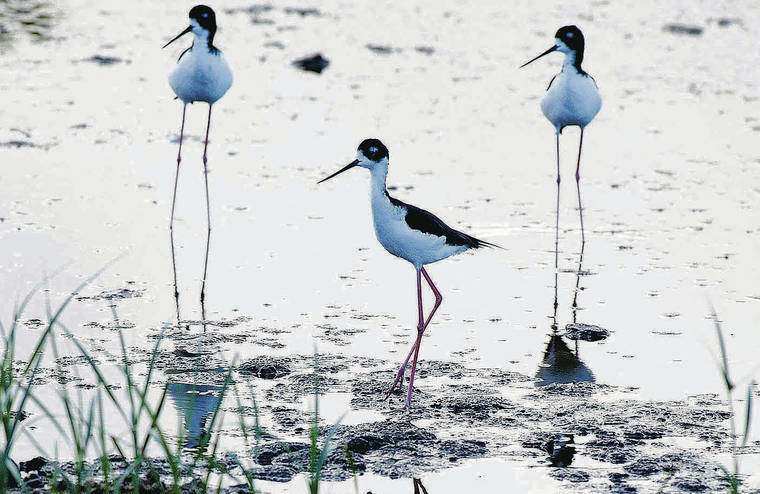Column: Hawaiian ae‘o still an endangered bird

STAR-ADVERTISER
The Ae‘o or Hawaiian Stilt are one of four endangered water bird speices found in Kawainui Marsh where the Department of Land and Natural Resources along with the Army Corps of Engineer broke ground for the construction of the Kawainui Marsh Environmental Restoration Project.

Linda M. B. Paul is president of the Hawaii Audubon Society.


The U.S. Fish and Wildlife Service (USFWS) has proposed downlisting the black-necked stilt, or ae‘o, from “endangered” to “threatened” under the Endangered Species Act (ESA), primarily because it estimates that the population has not increased since the last Hawaiian Waterbird Recovery Plan was published in 2011.
At the public hearing held on July 7, the USFWS said it has no plans to update the Recovery Plan. The Hawaii Audubon Society finds the USFWS’s logic and proposed action mystifying. All of the threats that existed in 2011 exist today: loss of nesting habitat, pollution, predation by rats, cats, mongooses and cattle egrets, etc.
Historically there were ae‘o on all of the major islands except Lanai and Kahoolawe. During the last century humans caused the ae‘o to dwindle significantly. Although there are no estimates of historic numbers, as with the other Hawaiian waterbirds, multiple writings suggest that ae‘o were common on Oahu in the late 1800s, but were scarce by 1900. The population declined to approximately 200 birds by the early 1940s due to hunting, loss of nesting habitat and predation by alien species. The ae‘o was finally listed as an endangered species on Oct. 13, 1970.
The population now averages around 1,500 birds (based on biannual Hawaiian waterbird surveys from 1998 through 2007), but fluctuates between approximately 1,100 and 2,100 birds, about a third of which are on Oahu.
The 2011 Ae‘o Recovery Plan identifies several core habitat areas on Oahu, but does not identify which of the core areas have viable nesting habitat. However, it states that the major threat hindering ae‘o recovery today is a “severe shortage of protected nesting areas.” Critical habitat designation is not a requirement for this species because ae‘o were listed before the ESA was amended to require it.
When asked about protecting nesting habitat at the recent hearing, the U.S. Fish and Wildlife Servic punted to the U.S. Army Corps of Engineers, saying that under the Clean Water Act (CWA), the Corps is charged with protecting wetlands. However, nesting habitat was and continues to be lost under Corps’ stewardship, with the Hawaii Kai wetlands being a prime example.
Don't miss out on what's happening!
Stay in touch with breaking news, as it happens, conveniently in your email inbox. It's FREE!
In 2017, Concerned Citizens of Hawaii and the Hawaii Audubon Society filed a 60-day notice of intent to sue under the ESA and the CWA over the mismanagement of ae‘o nesting habitat in Hawaii Kai. Since that time, the Society has monitored this habitat with drone flights, and no further destruction due to dumping of dredge spoils has occurred.
Congress never intended that a species stay on the endangered list for 50 years. However, rather than taking proactive management actions that will lead to the recovery of the ae‘o and ultimately removal from ESA lists, the USFWS proposes downlisting the species to threatened, seemingly content with the ae‘o population remaining at such low levels that a single hurricane hitting Oahu dead center could wipe out the entire island population. The public has through July 23 to comment on the Service’s proposed downlisting.
Linda M. B. Paul is president of the Hawaii Audubon Society.



